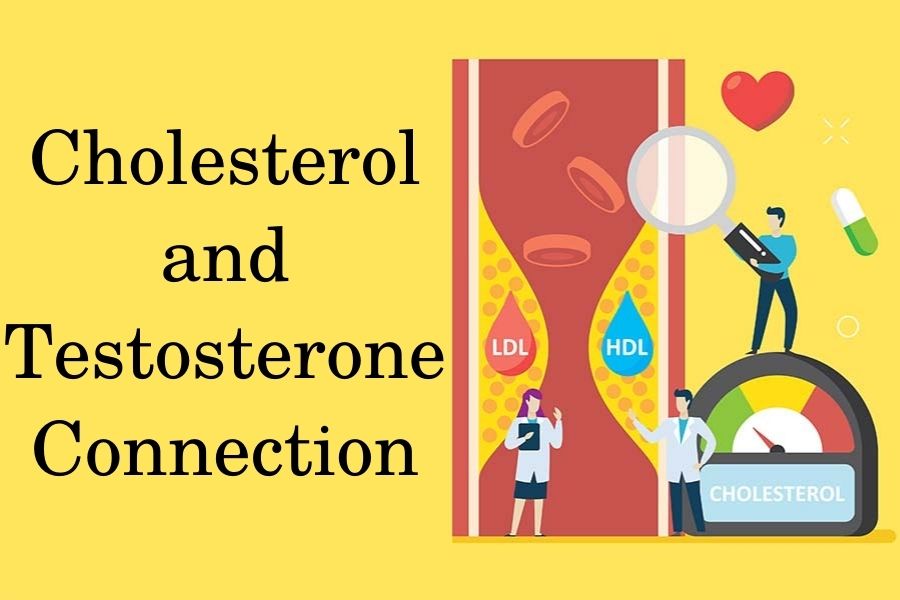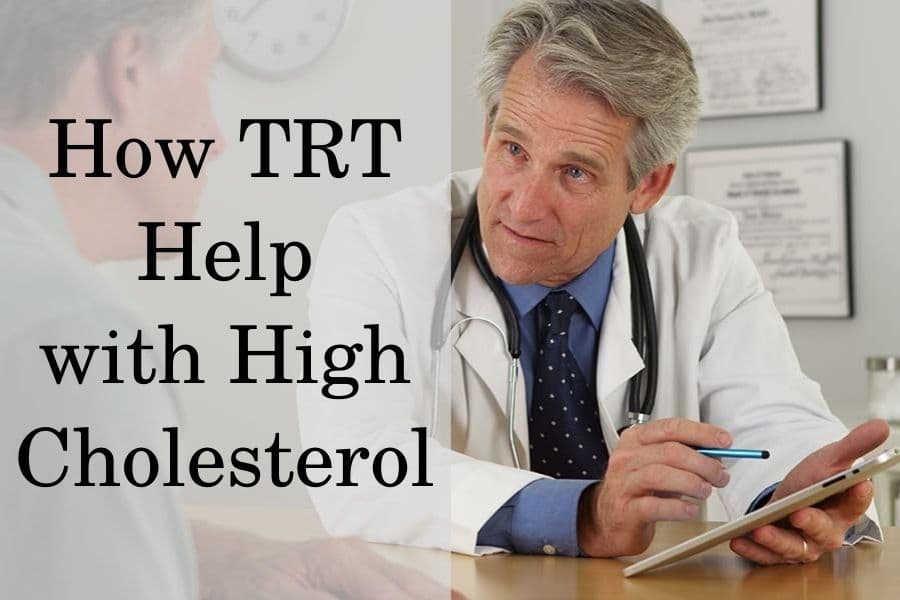Cholesterol levels are tightly related to the hormonal balance. For example, the body needs cholesterol to produce steroid hormones such as testosterone, estrogens, progesterone, cortisol, aldosterone, and others.
On the other hand, there are several hormones that regulate the metabolism of cholesterol and its serum levels in the body. These include testosterone, growth hormone, thyroid hormones, and glucagon.
Testosterone (T) is one of the steroids produced from cholesterol. Despite that fact, high cholesterol and low T usually go hand in hand.
In reality, scientists are still investigating the complex relationship between your metabolism, testosterone, and cholesterol levels.
Nevertheless, increasing T levels via testosterone replacement therapy (TRT) is consistently shown to improve cholesterol in men with hypogonadism (low T).
What is the relationship between cholesterol and testosterone?
Cholesterol has several vital functions in your body, which is why your liver produces it regardless of whether you consume it with your diet or not.
For example, cholesterol builds up the membranes of all your cells and it’s the main building block for the synthesis of vitamin D, bile acids, and steroid hormones such as T.
The conversion of cholesterol to testosterone goes through several intermediate compounds including progestogens, dehydroepiandrosterone (DHEA), and androstenedione.
Dietary cholesterol doesn’t alter resting or mean testosterone
Consuming more cholesterol with your food won’t raise your T levels. That’s likely because dietary cholesterol does not appear to affect your serum cholesterol levels, except for 15-25% of individuals who are hyper-responders.
Even in those considered hyper-responders, an effect of dietary cholesterol on testosterone is not likely.
That’s because the ratio between LDL-C (“bad” cholesterol) and HDL-C (“good” cholesterol) remains the same in hyper-responders after consuming a high cholesterol diet. This means the net balance of transported cholesterol in the body remains the same.
LDL and HDL are two of the protein transporters that carry cholesterol in your body. When cholesterol is attached to LDL (forming LDL-C) it gets carried from your liver to the organs that need it such as your testes.
Some of it may also get deposited in your arteries, which is a part of the process of atherosclerosis, and thus it’s bad for your cardiovascular health. That’s why LDL-C is also called the “bad cholesterol”.
On the other hand, HDL carries cholesterol from your tissues (including arteries) to the liver for removal. It also has antioxidative effects on LDL-C, which reduces its buildup in your arteries. HDL-C, LDL-C, and other minor cholesterol fractions together form the total cholesterol (TC) levels in your blood.
How to test cholesterol fractions
The best way to measure each fraction, as well as TC, is with a blood test called a lipid panel or lipid profile. You will need to fast between 8 to 12 hours before the test.
Your TC levels should be below 200 mg/dL. Values of 240 mg/dL and above are considered too high and you may be at an increased risk of heart disease, depending on the ratio between different cholesterol fractions.
| Total Cholesterol (TC) | HDL (Good) Cholesterol | LDL (Bad) Cholesterol | |
| Normal Levels | below 200 | 50 and higher (women); 40 and higher (men) | below 130 |
| Borderline High Levels | 200-239 | 40-49 | 130-159 |
| High Levels | over 240 | below 40 | over 160 |
Your “bad” cholesterol (LDL-C) should be less than 100 mg/dL, while your “good” cholesterol (HDL-C) should be at least 40 mg/dL in men but preferably above 60 mg/dL.
How high cholesterol levels affect testosterone
High LDL-C and TC levels are indicators of an increased risk of heart disease. There are many possible causes for such findings, one of which is low testosterone.
According to trials in older men, lower T correlates with higher TC levels. Furthermore, those with low T also had lower HDL-C levels, which further increases the atherogenic potential of high cholesterol.
On the other hand, the conditions causing high TC often result in low T as well. These include obesity, diabetes, advanced aging, and several chronic conditions.
In the case of obesity, managing the underlying cause improves both T and cholesterol levels.
High TC does not have symptoms, except for cholesterol deposits in the skin called xanthomas. They occur mostly in genetic conditions when cholesterol levels in the body are extremely high.
There are usually no symptoms of high cholesterol until complications develop
When coupled with high blood pressure and systemic inflammation due to obesity, lack of physical activity, smoking, etc. this leads to the accumulation of damage to the lining of your blood vessels, especially your arteries.
Cholesterol plaques build up on the damaged lining which causes atherosclerosis. If it keeps advancing, complications include heart problems, stroke, vascular diseases, and erectile dysfunction.
Effects of low cholesterol levels on testosterone
Having low HDL also speeds up the progression of atherosclerosis, even if TC and LDL-C are within the reference. That is because the less HDL there is in your blood, the less cholesterol it will clear from the body.
Low HDL is more common amongst men with obesity, insulin resistance, low physical activity, and higher markers of inflammation.
On the other hand, low LDL-C and TC levels are generally considered safe, and maintaining them as low as possible is recommended as a precaution against cardiovascular problems.
Some studies suggest that if your cholesterol is too low, this may have serious health consequences
For example, low TC levels are linked to symptoms of depression and may lead to an increased risk of suicide. TC is considered too low when its levels drop below 120 mg/dL.
Also, there might be a link between low LDL-C and an increased risk of cancer.
Also, low LDL-C may be associated with low T levels according to a study in 4203 men. That’s likely because of the critical role of LDL in delivering cholesterol to your testes for the synthesis of testosterone.
How does low T treatment help with high LDL cholesterol
Untreated hypogonadism may increase the risk for cardiovascular diseases. The available literature has consistently shown that hypogonadism is associated with an increased incidence of myocardial infarction, stroke, and mortality.
On the other hand, testosterone therapy may help normalize the lipid status of patients with low T and hypogonadism.
A recent meta-analysis of the available randomized controlled trials reports that TRT leads to a reduction of TC levels in men with low T. Furthermore, some of the included trials showed an increase in HDL-C.
Other reviews that also include non-randomized (lower quality) studies reveal mixed results. Some meta-analyses report a reduction in total cholesterol and an increase in HDL-C, while others report a decrease in both total and HDL cholesterol.
Nevertheless, none of the reviews reports an increased cardiovascular risk during TRT in men with low T.
How to always keep your cholesterol levels in balance
The most effective natural way to keep your cholesterol in check is to take steps towards a healthier lifestyle. More often than not, this will also help optimize T levels in otherwise healthy individuals.
Manage body weight and body fat percentage
First of all, you should maintain a normal body weight. If you have extra fat, especially around your waist, then burning it will likely result in a dramatic improvement of your lipid profile.
The fat around your waist and internal organs is called visceral fat and it is linked to elevated LDL, lower HDL, and increased risk of atherosclerosis.
Losing as little as 3% of body weight leads to a significant increase in HDL-C and reduction in LDL-C
Increasing your physical activity can help you lose weight and improve your lipid profile. Furthermore, high-intensity exercises appear to yield additional benefits for your HDL-C levels.
Manage intake of different fatty acids and cholesterol
The intake of cholesterol is rarely a problem in otherwise healthy individuals. As mentioned earlier, only 15-25% of people are hyper-responders, and consuming too much cholesterol will actually increase their serum levels.
Furthermore, there is insufficient evidence to suggest that dietary cholesterol increases cardiovascular risk even in hyper-responders. The balance between different dietary fats can have a significant impact on your TC, LDL-C, and HDL-C levels.
For example, make sure to avoid trans fats (hydrogenated plant fats) as they reduce HDL, increase LDL, and raise the risk of diabetes and heart diseases.
Also reduce your intake of certain saturated fatty acids, such as palmitic and myristic. Both of them increase LDL without affecting HDL significantly.
Replace foods rich in these fats with others that contain mono- and polyunsaturated fats. Omega-3 in fish oil is proven to increase HDL, while the oleic acid in olive and avocado oils is shown to lower both LDL-C and TC levels.
Yet, not all saturated fats are unhealthy. Stearic and lauric are saturated acids that can improve your lipid profile by lowering LDL and increasing HDL respectively. Also, get to know how the keto diet affects testosterone and whether it can increase it.
What can improve your lipid profile?
Quitting smoking is also going to help you improve your cholesterol levels. According to a study with 1504 smokers, quitting smoking improves HDL levels in all participants, even those who gained weight due to nicotine cessation.
Investigate the impact of smoking on testosterone levels in men
Vitamin B3 (niacin) is one of the most effective supplements that can increase HDL-C levels in patients with low HDL and is used as a reference for the effectiveness of other supplements.
For example, a randomized controlled trial with almost 800 patients revealed that niacin supplementation boosts HDL-C levels by more than 23%.
Get a free consultation with our medical expert for any questions about hormone replacement therapy



